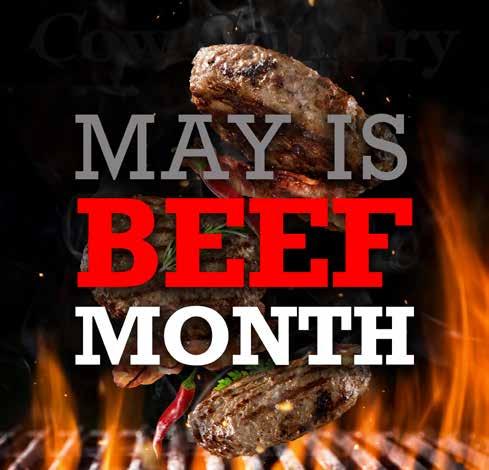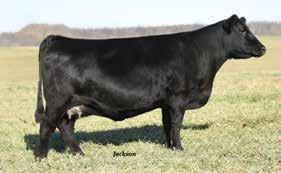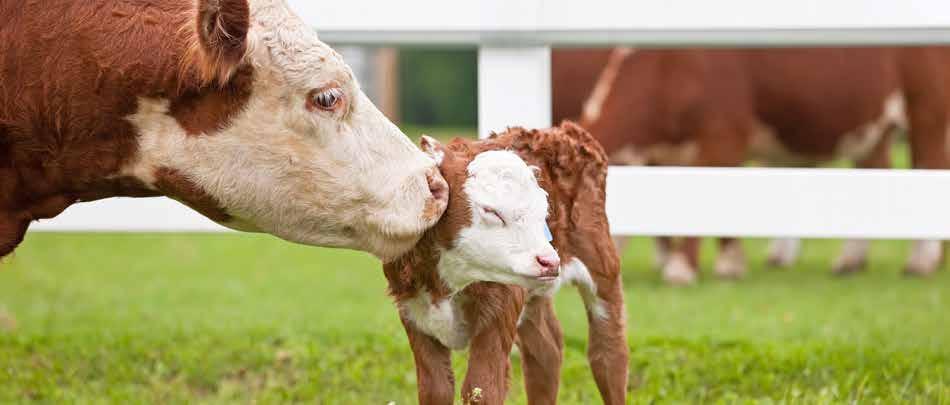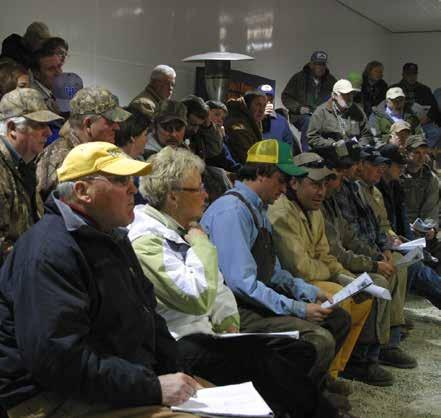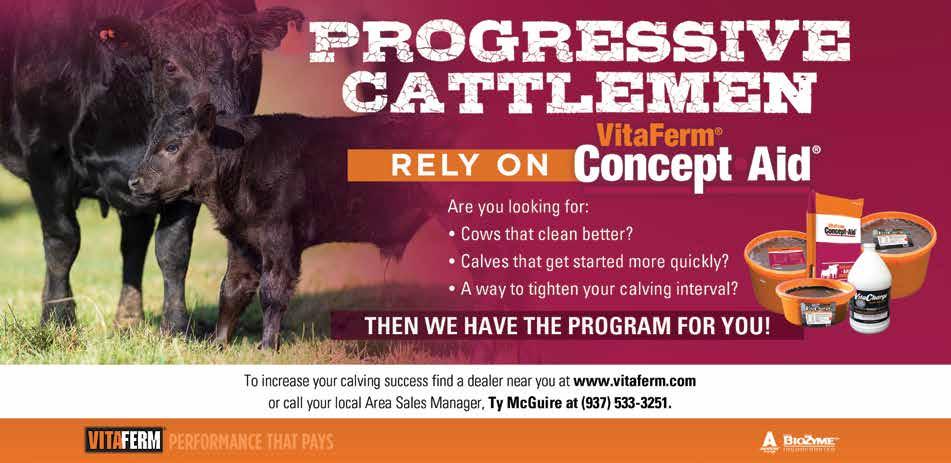
14 minute read
Dr. Michelle Arnold: UK Fundamentals of Herd Health
UK FUNDAMENTALS OF HERD HEALTH: VACCINATIONS FOR THE COW-CALF OPERATION
MICHELLE ARNOLD
DVM-Ruminant Extension Veterinarian, University of Kentucky
What vaccines should be given every year to help keep the cow/calf herd healthy? The basic guidelines below are designed to help answer that question but the details of what products to use and when to administer them are best decided by the producer with his or her veterinarian. Every farm is different with regards to the disease risk and other challenges including labor and facilities needed to work the cattle. Your veterinarian is equipped with the knowledge and skills to determine what will work best for your unique situation. Always consult your veterinarian before instituting or changing any health protocol. Remember: “Vaccination” (drawing up the vaccine in a syringe and injecting it into the animal) is not the same as “immunization” (the animal mounts an immune response) and “vaccination + immunization” never adds up to 100% protection from infection, even in the best of circumstances. The vaccines must be handled correctly (proper mixing, right temperature) and cattle in good health (low stress environment, good plane of nutrition, trace mineral needs met, minimal parasites present) in order to get the most response from vaccines. The provided list of vaccines and dewormers on pages 36 and 37 is for example purposes only and should not be considered an endorsement of products by the University of Kentucky.
COWS AND BULLS 4-6 WEEKS
PRIOR TO BREEDING
1. Viral respiratory vaccine (IBR, BVD, PI3, BRSV) and 5-way Leptospirosis. If using bulls for breeding, include Campylobacter fetus (Vibriosis). If the cow is open at the time of vaccination,select amodifiedlivevaccine (List C1A or B). If the cow is pregnant at the time of vaccination or less than 30 days before breeding, select a killed vaccine (List C2A or B) to reduce the risk of accidental abortion or interference with pregnancy. Certain modified live vaccines can be used in pregnant animals but only if used strictly according to label directions. Products with “FP” in the name stands for Fetal Protection from BVD virus. 2. 7 way or 8 way Clostridial (Blackleg)necessary if under 2 years of age. Optional as the cow ages depending on the exposure risk of the herd. (List C5 A-D) 3. Deworm-perform at least once per year (spring and possibly fall) and twice a year if under 2 years of age or thin body condition. If only once is possible, deworm in Spring (May). **Deworm at least 2 weeks prior to bull turn out or before estrus synchronization for artificial insemination (AI) due to temporary impact on hormone release in females.** Deworming in the fall helps to reduce the number of worms that overwinter in the cow but is not as important as spring when larvae are active in the pasture. (List C6 A or B) 4. Tag cattle for identification and/or retag those that have lost tags. 5. Breeding Soundness Exams are highly recommended for herd bulls and should be conducted 60-75 days prior to turnout. Bulls need the same vaccinations and deworming as the cow herd.
OPEN HEIFERS AT LEAST 6 WEEKS PRIOR TO BREEDING
1. Viral respiratory vaccine (IBR, BVD, PI3, BRSV) with 5-way Leptospirosis. If using bulls for breeding, include Campylobacter fetus (Vibriosis). Modified live vaccines are preferred (List C1A or B) for heifers. A Fetal Protection (FP) product is encouraged. Follow all label directions; some vaccines require a booster and some do not. Timing is very important-if less than 6 weeks away from breeding, use a killed product (List C2A or B). 2. 7 or 8- way Clostridial (Blackleg) (List C5 A-D) 3. Deworm with a branded (not generic) product (List C6 A or B). A heifer has increased nutritional demands because she is still growing herself, trying to reproduce, and young animals do not have the immunity to parasites that adult cattle possess. A very effective combination is to use an oral (white) dewormer from list C6A and an injectable or pour-on dewormer from list C6B, given at the same time.
CALVES 1-3 MONTHS OF AGE
1. Identify with tag 2. Vaccinate with 7 way Clostridial (Blackleg) vaccine-Although the calves are young, this dose of vaccine will initiate (“jump start”) the immune process, especially cell-mediated immunity. Do not give blackleg vaccine at birth. (List D5 A-D) 3. Dehorn 4. Castrate-the earlier this is completed, the better. Avoid the first 24 hours after birth. 5. Optional Practices: a. Implant steers at the time of castration (unless you plan to sell calves in an organic or natural market) b. Viral Respiratory Vaccine-Killed (List D2) or MLV (List D1 but follow label directions regarding MLV usage in nursing calves). Intranasal vaccines are great for young calves. c. Pinkeye vaccine (administer in late spring/summer just before fly season) (List D7) d. Deworm-Begin deworming calves at 6-8 weeks old depending on time of year and expected level of pasture contamination with parasite larvae. (List D6 A or B) e. Test for BVD-PI (ear notch)-
Consult your veterinarian if this is something to consider. If BVD has been diagnosed in an animal from your farm or there is a history of unexplained abortions, stillbirths, weak calves or other reproductive loss in the herd, testing all calves is the proven first step to find persistently infected (PI) animals. Try to wait until the calf is at least 14 days of age to take an ear notch sample.
CALVES 2-3 WEEKS
PRE-WEANING (BEST) OR
SHORTLY AFTER WEANING
Consult your veterinarian and check your marketing plan since many programs (for example: CPH45) specify what vaccines must be administered and when in order to participate. Administer vaccines 2-3 weeks preweaning for best protection. If calves cannot be processed pre-weaning, then begin this protocol after weaning when the stress is essentially over (calves are eating, drinking, and the majority have stopped walking and bawling). Booster vaccines if required by label. If castrations and dehorning were not done earlier, these practices need to be completed as soon as possible. Tetanus vaccination is strongly recommended when performing “late” castration; especially if banding. Consult your veterinarian regarding whether to use a tetanus toxoid or antitoxin. 1. Viral respiratory vaccine (IBR, BVD, PI3, BRSV)-Killed (List D2) or MLV (List D1) but follow label directions regarding MLV usage in nursing calves if vaccinating before weaning. If using killed, a booster is required. A majority of buyers prefer calves that have received 2 doses of MLV. See point #3a below for additional viral respiratory vaccine
option. 2. For Heifers to be kept as Replacements: Viral respiratory (as above) with Campylobacter fetus (Vibriosis) and 5-way Leptospirosis vaccine included. Booster according to label directionsMLV is strongly recommended for females to be kept in the herd. (List C1B) 3. Vaccinate with Mannheimia haemolytica toxoid. This vaccine, commonly known as a “Pasteurella shot” or “Pneumonia shot” is given preweaning in anticipation of the stress associated with weaning. (List D3) a. Many combination Mannheimia haemolytica toxoid and MLV
Respiratory Virus Vaccines are available such as Pyramid 5 +
Presponse (BI), Vista Once (Merck), or Bovi-Shield Gold One Shot (Zoetis) (List D4) 4. Deworm with an endectocide (List D6A) for internal and external parasites. Use a branded product-not a generic. A “drench” or “white” dewormer given by mouth (List D6B) may also be used but a second product is required for external parasite (lice/flies/ticks) control. The best option is to administer an injectable (or pour-on) dewormer (List D6A) and a drench dewormer (List D6B) at the same time. 5. 7- or 8- way Clostridial vaccine (Blackleg). Clostridial vaccines may be purchased alone or in combination with pinkeye, “somnus” and other antigens. Follow label directions regarding the need for a booster. (List D5 A-D) 6. Optional: a. Implant-Follow label directions if re-implanting. Do not implant females to be used for breeding purposes. Do not implant if planning to sell on the natural or organic markets. b. Pasteurella multocida and/or
Histophilus somni (formerly known as Hemophilus somnus) vaccinesconsult your veterinarian for recommendations.
COWS AFTER CALVES ARE WEANED
1. Check cows for pregnancy by palpation, ultrasound, or blood test. If open, strongly consider culling her. 2. Check for other problems: Eyes, teeth, udder, feet and legs, body condition, disposition. 3. Scours Vaccine (List C8) –Administer to pregnant cows 1-3 months prior to calving. Initially this is a two-shot series then it is given annually. Products vary on when to administer them so follow label directions carefully. 4. If leptospirosis is a persistent problem, cows may need a booster of 5-way Leptospirosis vaccine such as Spirovac (Zoetis) for continued strong protection during the third trimester of pregnancy.
ADDITIONAL CONSIDERATIONS
1. *Modified Live Vaccines (MLV) provide fast, broad immunity and are excellent stimulators of cell-mediated immunity. They are preferred in weaned calves and usually required by most preconditioned sales. However, only use modified live vaccines in pregnant cows and in nursing calves if the cows were vaccinated with MLV, usually within the last 12 months (check label for specific requirements; some are less than 12). If this requirement is not met, a killed vaccine must be used until the cow is open and the calf is weaned. 2. Killed respiratory virus vaccines must be given twice (usually 2-3 weeks apart) if it is the first time the vaccine is administered. Annual boosters are required after the initial two-shot sequence. Killed vaccines are safer than MLV vaccines but they do not work nearly as well nor last as long. 3. If heifers have been allowed to stay with the herd bull until weaning, most likely some are pregnant. A prostaglandin injection (for example: Lutalyse®) can be given to the heifers once they have been away from the bull a minimum of 10 days. These injections work best in early pregnancy (<75 days) so do not delay administration if needed. 4. Try to minimize the number of injections given at one time as much as possible. Multiple vaccinations cause neck soreness. Multiple Gram negative vaccines (for example, leptospirosis, vibriosis, pinkeye) may cause cattle to spike a fever and go off feed for a short period of time. 5. Keep good vaccination records. Record date, vaccine name, serial numbers and expiration dates at a minimum. 6. Utilize effective fly control and pinkeye vaccine beginning in late spring. Follow label directions regarding booster vaccines. If using feed/mineral additives for fly control, make sure to start them 30 days before fly season and keep it in until 30 days after fly season is over. 7. Anaplasmosis- Kentucky is among the list of states approved by the USDA for sale of the anaplasmosis vaccine marketed by University Products LLC of Baton Rouge, La. The vaccine is used in cows in all stages of pregnancy with no problems being reported. The recommendation is a 2 dose regimen given 4 weeks apart with annual revaccination required. Protective immunity should develop within 7-10 days according to the manufacturer. The primary or initial dose is given to bred heifers and young bulls. Consult your veterinarian for options. 8. Letters in a vaccine name mean: a. IBR, BVD, BRSV and PI3 : Diseases included in a viral respiratory vaccine. b. An “FP” in the vaccine name stands for “fetal protection” and means protection against fetal persistent infection and abortion due to the
BVD virus. c. An “HB” in the vaccine name stands for the strain of Leptospira known as “Hardjo bovis” that is a common cause of reproductive failure in cattle. d. “HS” stands for “Histophilus somni” (formerly known as
Haemophilus somnus) e. “L5” stands for the 5 strains of
Leptospirosis. f. “V” stands for “Vibriosis” Vaccination programs must be designed around the specific needs of your cattle. Talk to your vet!
EXAMPLES OF VACCINES AND DEWORMERS ON PAGE 36-37
EXAMPLES OF VACCINES AND DEWORMERS FOR COWS, REPLACEMENT HEIFERS & BULLS£
C1A Modified Live Virus Vaccines with Leptospirosis *Pyramid 10 - Boehringer Ingelheim *Vista 5 L5 —Merck *Express FP10 —Boehringer Ingelheim *Bovishield Gold FP5 L5 HB — Zoetis *Titanium 5 L5 HB — Elanco *Labeled for use in pregnant cattle and nursing calves —follow directions carefully
*Express FP 5 VL5– Boehringer Ingelheim *Bovi-Shield Gold FP5 VL5 HB-Zoetis *PregGuard Gold FP 10 (No BRSV)- Zoetis *Vista 5 VL5 SQ-Merck
C5B Clostridial (Blackleg) + Pinkeye
C5B Clostridial (Blackleg) + Pinkeye Alpha 7/MB— No booster—Boehringer -Ingelheim 20/20 Vision 7 with SPUR-Merck
C2A Killed Virus Vaccines with Lepto Triangle 10 HB—Boehringer Ingelheim Cattlemaster Gold FP5 L5— Zoetis Vira Shield 6 + L5 HB— Elanco Master Guard 10 HB-contains killed IBR and BVD-Elanco
C2B Killed Virus Vaccines + Lepto and Vibrio Cattlemaster 4 +VL5-Zoetis Vira Shield 6 + VL5 (HB)— Elanco
C4 Modified Live Respiratory Virus Vaccines + Mannheimia toxoid *Pyramid 5 + Presponse SQ —Boehringer Ingelheim *Vista Once SQ — Merck *Bovi-Shield Gold One Shot—Zoetis *Titanium 5 + PHM—Elanco *Inforce 3 (intranasal) + One Shot BVD-Zoetis *Labeled for use in pregnant cattle and nursingcalves —follow directions carefully
C8 Scours Vaccines Guardian-Merck ScourGuard 4KC-Zoetis Scour Bos 9 and 4– Elanco
£ The provided lists of vaccines and dewormers is for example purposes only and should not be considered an endorsement of products by the University of Kentucky.
EXAMPLES OF VACCINES AND DEWORMERS FOR NURSING CALVES AND WEANED/FEEDERS
D1A Modified Live Virus Vaccines (Often called “Live Virus”) *Pyramid 5 - Boehringer Ingelheim *Vista 5 —Merck *Inforce 3 (Intranasal) + Bovishield BVD —Zoetis *Express 5 —Boehringer Ingelheim *Bovishield Gold 5 — Zoetis *Titanium 5 — Elanco *Bovilis Vista BVD + Bovilis Nasalgen 3 (Intranasal)—Merck *Labeled for use in pregnant cattle and nursing calves
D1B Modified Live Virus Vaccines + Somnus *Express 5-HS– Boehringer Ingelheim Resvac 4/Somubac-Zoetis
D2A Killed Virus Vaccines Triangle 5—Boehringer Ingelheim Cattlemaster Gold FP5 — Zoetis Vira Shield 6 — Elanco Master Guard 5-contains killed IBR and BVD-Elanco
D2B Killed Virus Vaccines + Somnus Elite 4-HS—Boehringer Ingelheim Vira Shield 6 Somnus— Elanco
D4 Modified Live Respiratory Virus Vaccines + Mann-heimia toxoid *Pyramid 5 + Presponse SQ —Boehringer Ingelheim *Vista Once SQ — Merck *Bovi-Shield Gold One Shot—Zoetis *Titanium 5 + PHM—Elanco *Inforce 3 (intranasal) + One Shot BVD-Zoetis *Bovilis Vista BVD CFP + Bovilis Nasalgen 3– PMH(Intranasal)- Merck *Labeled for use in pregnant cattle and nursing calves —follow directions carefully
D5A Clostridial (Blackleg) 7 or 8 Way Vaccines
D5B Clostridial (Blackleg) + Pinkeye
Alpha 7/MB1— No booster—Boehringer -Ingelheim 20/20 Vision 7 with SPUR-Merck Piliguard Pinkeye + 7—Merck
D8 Scours Vaccines Bovilis Coronavirus (Intranasal, Coronavirus Only)- Merck Bar-Guard-99 (Oral, E. Coli K99 Only) - Boehringer Ingelheim Calf-Guard (Oral, Rota– and Coronavirus)– Zoetis First Defense (Oral, E.coli K99, Corona)& First Defense TriShield (Oral, E.Coli K99 + Coronavirus + Rotavirus )- Immucell Corp.


